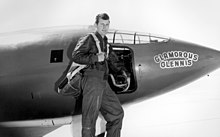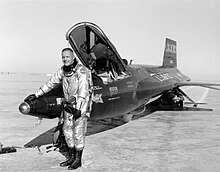Test pilot
A test pilot , formerly test pilots , is an experienced and specially trained pilot , whose main task is the testing of aircraft and their counting systems. He is responsible for carrying out a flight test program that is usually precisely defined in advance. A typical subject of such test programs is z. For example, flying to the limit areas of an aircraft (e.g. speeds, take-off weights , stalling and spin behavior), testing new components or demonstrating flights for certification.
history
The first systematic tests of aircraft were carried out at the Royal Aircraft Establishment (RAE) in Great Britain during World War I. In the 1920s, these test flights and their implementation at the RAE and at the NACA in the USA continued. When the NACA was transferred to NASA in 1958 and the focus of the test flights shifted to the areas of stability and handling, the work of the test pilot developed into a much more technical-scientific approach. From this time on, more emphasis was placed on the quality and reproducibility of the test flights.
schools
The world's oldest test pilot school is the military Empire Test Pilots' School ( ETPS ) in Boscombe Down , Wiltshire , UK , which is now operated by QinetiQ for the UK MoD in a public-private partnership . In Europe, apart from the ETPS, there is also the military EPNER (Ecole du Personnel Navigant d'Essai et de Reception) in Istres , France , and the center for aerospace training and flight testing at the Michail Gromov Aeronautical Research Institute in Zhukovsky near Moscow, Russia . In the United States, the U.S. Air Force Test Pilot School at Edwards Air Force Base and the U.S. Navy Test Pilot School at Naval Air Station Patuxent River, Maryland , are the major military training centers for test pilots and flight test engineers. In California , the private test pilot school NTPS is also located on the Mojave Air & Space Port . The private ITPS (International Test Pilot School), which was previously based in Woodford , Great Britain, moved to Canada in 2006 . There are other test pilot schools in Brazil and India , for example .
education
In order to become a test pilot, a candidate must have the following classic characteristics, in addition to having completed pilot training :
- The ability to understand a given test program and to implement it with the greatest possible precision,
- the ability to accurately and comprehensively document each test,
- an excellent grasp of the aircraft and the ability to accurately analyze unusual behavior of the aircraft during a test,
- the ability to quickly resolve problems with the aircraft during a test; and
- the ability to deal with many (wrong) things at the same time ( multitasking ).
In addition, a test pilot generally needs a university degree in science or engineering , ideally aeronautical engineering, mechanical engineering or electrical engineering. Only in this way is he able to understand highly complex relationships in the testing phase of newly designed aircraft and to represent the findings in a mathematical way. This is followed by a six to twelve month theory phase at one of the internationally recognized test pilot schools. This is divided, using the example of the test pilot school of the US Air Force, into theoretical lessons, training in the simulator and practical exercises in various types of aircraft, from single-engine aircraft to transport machines to military fighter aircraft. Since the training is very expensive, most of the graduates come from the national air forces. They have both the engineering studies that have been compulsory for years and the necessary flying experience. The practical part consists of the four main phases "Execution & Efficiency", "Aviation Skills", "Systems" and "Test Management". The training is extremely demanding and provides the prospective test pilot with all the skills needed to fly and test any aircraft or avionics systems.
tasks

Test pilots work for military or civil organizations, such as aircraft manufacturers or airlines, in various areas of activity, from the first flight of a new aircraft prototype to testing the aircraft and its equipment through to the final acceptance of a series aircraft before delivery to the customer. This aeronautical test includes, among other things, flying to the limit areas, e.g. the minimum and maximum speeds in different configurations (retracted and extended landing gear , different flap positions , etc.). The behavior of the aircraft in unusual flight conditions, such as in a spin or stall is also examined. The methods of avoiding these flight conditions and, if necessary, of eliminating them again, are also (co-) developed by test pilots during the flight tests. Furthermore, maximum take-off and landing weights are determined and tested, emergency procedures in the event of failure of components of the aircraft are developed and tested, and efficient methods of operating the aircraft are developed. The generation of data for the validation of calculation and simulation models is also part of the task of test pilots. Of course, the components and systems of a new aircraft are also thoroughly checked by test pilots in flight before they are handed over to the customer.
In addition to the flying tests, test pilots are involved in the development of the test programs, the documentation and the evaluation of the individual tests and, thanks to their training, can give the development engineers feedback on the flight and avionics systems tested. The training of the trainers is also part of their duties. Last but not least, test pilots are called in to investigate aircraft accidents as specialists or for tests.
hazards

Unusual situations can arise at any time during test flights. Be it because components and systems fail, or because they react differently than intended. Depending on whether and how a test pilot reacts to these situations, there is a risk of a serious accident or, in the worst case, a crash. To minimize these dangers, test programs are therefore usually designed step by step, building on one another. Test programs are also increasingly being replaced or calculated in advance by computers and simulations. This significantly reduces the risk for the test pilot.
More test pilots
Also referred to as test pilots are pilots who use new aircraft in various aviation sports, e.g. B. paragliders , hang gliders or Speedflyer test fly and test. Here, too, just like in an airplane, speeds are flown and limit areas are tested. Since this is sports equipment, some of which are later flown by inexperienced pilots, the reaction of the aircraft to delayed and incorrect reactions by the pilot also plays a major role in these tests. Although these test pilots have a great influence on the design through their feedback on the flight behavior of the aircraft, a natural science degree is rarely required; Above-average skills and years of experience are “sufficient”.
In motorsport, for example, in Formula 1 drivers are referred to as test pilots who try out the racing cars alongside the regular drivers but do not compete in the races . Another common term in this context is test driver.
Test pilots in space travel
From July 17, 1962 to August 21, 1968, 13 flights of the X-15 reached an altitude of over 50 miles. According to the US definition, space begins there, so that the eight pilots on these flights in the USA are considered space travelers . The five military pilots Robert White, Robert Rushworth, Joe Engle, William Knight and Michael Adams received astronaut wings as an award for this achievement . The three civilian pilots involved in the X-15 program were only honored with the wings on August 24, 2005. Bill Dana received the award himself; the late pilots Joe Walker and John McKay were represented by relatives.
According to the definition of the Fédération Aéronautique Internationale (FAI), the limit to space is 100 km. Only two of the X-15 flights exceeded this limit: Flight 90 on July 19, 1963 at 106,010 m and the flight on August 22, 1963 at 107,960 m. Both times the pilot was Joe Walker, so, according to international definition, he was the only pilot who reached space with the X-15.
The first seven astronauts in NASA's space program Alan Shepard , Virgil Grissom , John Glenn , Scott Carpenter , Walter Schirra , Deke Slayton , and Gordon Cooper were all military test pilots. Many of the pilots on the space shuttle missions were also former test pilots.
Famous test pilots
( Sorting freely selectable )
|
See also
literature
- Richard P. Hallion: Test Pilots. Frontiersmen of Flight. Smithsonian Press, Washington DC 1988, ISBN 0-87474-549-7 .

